Contact
malin.elfstrand@slu.se, 018-671579

At our Department you can do bachelor’s or masters work in applied as well as basic research subjects. We offer degree projects in for example plant pathology, forest pathology, nature conservation, population biology, genomics, soil biology and carbon and nitrogen cycles in the soil.
If you are interested in doing a degree project with us, please contact the director of studies or any of the researchers at the department. Examples of previous bachelors and Master theses at the department can be found in the list in the blue box further down on this page.
A Master thesis usually comprises 30 credits (20 weeks full-time studies). You work independently with supervisors from the department and possibly also from companies, authorities or other institutions. Once you have decided on a project and a supervisor, you and your supervisor will draw up your thesis work plan and contact the director of studies at the department who will ensure that you are registered, that you have been appointed examiner and that a work plan is drawn up and written.
The thesis work can be classified in different subjects depending on the program you are taking. We provide degree projects in biology, soil science and forest science. To qualify, a minimum of 30 credits is required at the advanced level in the subject of your degree project.
For Forest science students, there is also the opportunity to do a 60 ECTS (40 weeks) Master thesis. These projects are integrated in ongoing research projects at the department and the objective is that the work should be published in a scientific article. If you are interested in postgraduate education, it is a good opportunity to try a bigger challenge and gain an insight into the activities of a research team and the institution!
Second cycle, A2E
Second cycle, A1E
First cycle, G2E
The oomycete pathogen Aphanomyces euteiches causes root rot in various legume species such as in pea (Pisum sativum L.). Aphanomyces root rot is the major constraint for increased pea production in Europe and can cause very high yield losses and affect quality negatively. The last day to apply is 30 April 2022.
We’re looking for a motivated, reliable student with a keen interest in plant breeding and phytopathology. Basic knowledge of statistics and R, as well as basic lab experience are a plus.
The fungal pathogen Hymenoscyphus fraxineus causing Ash dieback (ADB) disease has spread rapidly on the European continent, threatening common ash (Fraxinus excelsior) with extinction. This project aims to study variation in trees with varying levels of tolerance to ADB. The focus of the project is COUMARIN SYNTHASE (COSY). The COSY enzyme is involved in the biosynthesis of coumarins, catalysing the biosynthesis of the defensive compounds fraxetin and esculetin. These compounds are known to help ash trees to tolerate ADB.
Based on available genomic information, we hypothesize that allelic variation in COSY between tolerant and susceptible trees can explain the higher levels of coumarin accumulation in trees with high tolerance to ADB. To test this hypothesis, we plan to i) identify and isolate the COSY genes in ash; ii) compare the sequence variation in trees with known levels of tolerance to ADB and known levels of fraxetin and esculetin iii) express ash COSY in a heterologous system and determine its catalytic properties.
In this project you would work in close interaction with researchers at the Irish Agriculture and Food Development Authority (TEAGASC) and Queen Mary University of London.
For further information, please contact:
Malin Elfstrand
Forest Mycology and Plant Pathology, SLU
Malin.Elfstrand@slu.se, 018-671579
Miguel Nemesio Gorriz
Teagasc Food Research Centre,
miguel.nemesiogorriz@teagasc.ie, +353 (0)18059551 / +353 (0) 873504965
malin.elfstrand@slu.se, 018-671579